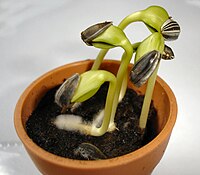
Photo from wikipedia
Increasing air temperature and atmospheric CO₂ levels may affect the distribution of invasive species. Whereas there is wide knowledge on the effect of global change on temperate species, responses of… Click to show full abstract
Increasing air temperature and atmospheric CO₂ levels may affect the distribution of invasive species. Whereas there is wide knowledge on the effect of global change on temperate species, responses of tropical invasive species to these two global change drivers are largely unknown. We conducted a greenhouse experiment on Terminalia catappa L. (Combretaceae), an invasive tree species on Brazilian coastal areas, to evaluate the effects of increased air temperature and CO₂ concentration on seed germination and seedling growth on the island of Santa Catarina (Florianopolis, Brazil). Seeds of the invasive tree were subjected to two temperature levels (ambient and +1.6 °C) and two CO₂ levels (ambient and ~650 ppmv) with a factorial design. Increased temperature enhanced germination rate and shortened germination time of T. catappa seeds. It also increased plant height, number of leaves and above‐ground biomass. By contrast, increased atmospheric CO₂ concentration had no significant effects, and the interaction between temperature and CO₂ concentration did not affect any of the measured traits. Terminalia catappa adapts to a relatively broad range of environmental conditions, being able to tolerate cooler temperatures in its invasive range. As T. catappa is native to tropical areas, global warming might favour its establishment along the coast of subtropical South America, while increased CO₂ levels seem not to have significant effects on seed germination or seedling growth.
Journal Title: Austral Ecology
Year Published: 2019
Link to full text (if available)
Share on Social Media: Sign Up to like & get
recommendations!